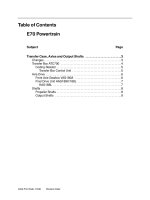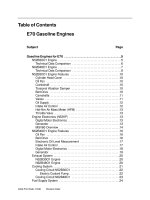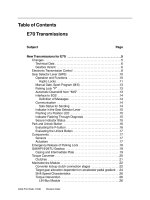D2859 02
Bạn đang xem bản rút gọn của tài liệu. Xem và tải ngay bản đầy đủ của tài liệu tại đây (19.81 KB, 3 trang )
Designation: D 2859 – 02
Standard Test Method for
Ignition Characteristics of Finished Textile Floor Covering
Materials1
This standard is issued under the fixed designation D 2859; the number immediately following the designation indicates the year of
original adoption or, in the case of revision, the year of last revision. A number in parentheses indicates the year of last reapproval. A
superscript epsilon (e) indicates an editorial change since the last revision or reapproval.
2. Referenced Documents
2.1 ASTM Standards:
D 123 Terminology Relating to Textiles Materials2
D 418 Methods of Testing Pile Yarn Floor Covering Construction2
D 1116 Test Method for Resistance of Pile Floor Coverings
to Attack by Black Carpet Beetle Larvae3
D 1230 Test Method for Flammability of Apparel Textiles2
D 1335 Test Method for Tuft Bind of Pile Floor Coverings4
D 1776 Practice for Conditioning Textiles for Testing2
D 2401 Test Method for Service Change of Appearance of
Pile Floor Coverings5
D 2646 Test Methods for Backing Fabrics2
D 3411 Test Method for Flammability of Textile Materials6
2.2 AATCC Standard:
Method 138-1972, Shampooing: Washing of Textile Floor
Coverings7
1. Scope
1.1 This fire-test-response standard describes a test method
for the determination of the flammability of finished textile
floor covering materials when exposed to an ignition source
under controlled laboratory conditions.
1.2 This test method is applicable to all types of textile floor
coverings, regardless of the method of fabrication or whether
they are made from natural or man-made fibers. It is possible
to apply this test method to unfinished material; however, the
results of such a test shall not be considered a satisfactory
evaluation of a textile floor covering material for ultimate
consumer use.
1.3 The values stated in inch-pound units are to be regarded
as the standard. The values given in parentheses are for
information only.
1.4 This standard is used to measure and describe the
response of materials, products, or assemblies to heat and
flame under controlled conditions, but does not by itself
incorporate all factors required for fire hazard or fire risk
assessment of the materials, products, or assemblies under
actual fire conditions.
3. Terminology
3.1 Definitions:
3.1.1 finished, adj—in textile floor covering materials, the
completion of all manufacturing operations.
3.1.2 flame retardant, n—a chemical used to impart flame
resistance.
3.1.3 flame-retardant treatment, n—a process for incorporating or adding flame retardant(s) to a material or product.
3.1.3.1 Discussion—The term “flame-retardant treatment”
does not apply to textiles that are inherently-flame-resistant due
to the intrinsic properties of the material or the fiber-forming
polymer.
3.1.4 flame resistance, n—the property of a material
whereby flaming combustion is prevented, terminated, or
inhibited following application of a flaming or nonflaming
source of ignition, with or without subsequent removal of the
ignition source.
3.1.4.1 Discussion—Flame resistance can be an inherent
NOTE 1—For other standards on flammability of textiles, refer to: Test
Methods D 1230 and D 3411. For methods of measuring other properties
of floor coverings and components thereof, refer to: Test Methods D 418,
D 1116, D 1335, D 2401, and D 2406.
1.5 Fire testing of products and materials is inherently
hazardous, and adequate safeguards for personnel and property
shall be employed in conducting these tests
1.6 The text of this standard references notes and footnotes
which provide explanatory material. These notes and footnotes
(excluding those in tables and figures) shall not be considered
as requirements of the standard.
1.7 This standard does not purport to address all of the
safety concerns, if any, associated with its use. It is the
responsibility of the user of this standard to establish appropriate safety and health practices and determine the applicability of regulatory limitations prior to use.
2
Annual Book of ASTM Standards, Vol 07.01.
Discontinued, see 1979 Annual Book of ASTM Standards, Part 22.
4
Discontinued, see 1994 Annual Book of ASTM Standards, Vol 07.01.
5
Discontinued, see 1991 Annual Book of ASTM Standards, Vol 07.01.
6
Discontinued, see 1980 Annual Book of ASTM Standards, Part 32.
7
Technical Manual of the American Association of Textile Chemists and
Colorists, P. O. Box 12215, Research Triangle Park, NC 27709.
3
1
This test method is under the jurisdiction of ASTM Committee E05 on Fire
Standards and is direct responsibility of Subcommittee E05.22 on Surface Burning.
Current edition approved Sept. 10, 2002. Published November 2002. Originally
published as D 2859 – 70 T. Last previous edition D 2859 – 01.
Copyright © ASTM International, 100 Barr Harbor Drive, PO Box C700, West Conshohocken, PA 19428-2959, United States.
1
D 2859 – 02
6.7 Vacuum Cleaner, of which all surfaces contacting the
specimens are flat and smooth.
6.8 Laboratory Fume Hood, capable of being closed and
having its draft turned off during each test. The front or sides
of the hood should be transparent to permit observation of the
test in progress.
6.9 Methenamine Tablet.9
property of the basic material or product, or it may be imparted
by specific treatment. The degree of flame resistance exhibited
by a specific material during testing may vary with different
test conditions.
3.2 For definitions of other textile terms used in this method,
refer to Terminology D 123.
4. Summary of Test Method
4.1 This test method involves the exposure of conditioned
and oven-dried specimens to a standard source of ignition in a
draft-protected environment and the measurement of the resulting char length.
NOTE 2—Storage of the tablets in a desiccator will reduce cracking
upon ignition.
NOTE 3—The normal variation in the weight of different tablets will not
affect the test result.
7. Sampling, Selection, and Number of Test Specimens
7.1 Take a lot sample as directed by the applicable material
specification. In the absence of an applicable material specification or other agreement between the purchaser and the seller,
select a sample comprised of a roll or piece believed to be
representative of the lot to be tested. Each roll or piece must be
large enough to permit cutting eight specimens each 9 in. (230
mm) square, free of creases, fold marks, or any delamination.
7.2 If the textile floor covering material has had a fireretardant treatment (as defined in 3.2), wash the specimens as
directed in the washing procedure described in AATCC
Method 138-1972.
7.3 Cut eight specimens, each 9.0 6 0.1 in. (2306 3 mm)
square, from each sample.
5. Significance and Use
5.1 This test method provides a procedure for identification
of those finished textile floor covering materials that can be
rated as flame-resistant under specific controlled laboratory
conditions.
5.2 This test method does not specify the use of an underlay
material. If desired, the method may be used to assess the effect
of a specific underlay in combination with a specific floor
covering, but such a variation in procedure must be noted in the
report.
5.3 Results observed with the specimens in a horizontal
plane, as specified, may not be characteristic of the same
material when used in any other plane, particularly in a vertical
plane.
5.4 Test Method D 2859 for testing finished textile floor
covering materials for flammability is considered satisfactory
for acceptance testing of commercial shipments since the
method has been used extensively in the trade for acceptance
testing. In cases of disagreement arising from differences in
values reported by the purchaser and the seller when using this
method for acceptance testing, the statistical bias, if any,
between the laboratory of the purchaser and the laboratory of
the seller should be determined with each comparison being
based on testing specimens randomly drawn from one sample
of material of the type being evaluated.
8. Conditioning
8.1 Condition the specimens as directed in Practice D 1776.
9. Procedure
9.1 Clean each specimen with the vacuum cleaner until it is
free of all loose ends and of any material that may have been
worked into the pile during handling.
9.2 Place the eight conditioned specimens in an oven in a
manner that will permit free circulation of the air at 221 6 2°F
(105 6 2°C) for 2 h.
NOTE 4—Conditioning prior to the drying operation is specified because storage conditions may cause some material to be moist, thus
requiring considerably more than 2 h drying time.
NOTE 5—Multiple test samples can be dried concurrently.
6. Apparatus and Reagent
6.1 Test Chamber—A box with inside dimensions of 12 by
12 by 12 in. (305 by 305 by 305 mm) made from asbestoscement material,8 not less than 0.25 in. (6.4 mm) thick, open at
the top, and having a flat removable floor made of the same
material.
6.2 Frame—A steel plate, 9 by 9 in. (230 by 230 mm), 0.25
in. (6.4 mm) thick, with an 8.0-in. (205-mm) diameter hole cut
in the center of the plate.
6.3 Desiccating Cabinet, with an efficient desiccant, and
shelves large enough to hold 9 by 9-in. (230 by 230-mm)
specimens spaced separately in a horizontal position.
6.4 Circulating Air Oven, ventilated, forced-draft and thermostatically controlled in the atmosphere range of 221 6 2°F
(105 6 2°C) throughout the enclosure.
6.5 Glove, disposable, of polyethylene or rubber.
6.6 Steel Rule, graduated in 1⁄64-in. (0.4-mm) increments.
8
9.3 Remove the eight specimens from the oven with a
gloved hand and immediately place them in a dessicator for 1
h, or until they reach room temperature, whichever is longer,
making sure that the specimens are in a horizontal plane with
the pile side up, and that they are not resting on one another.
NOTE 6—Specimens taken from some carpet types may become distorted after drying, such that they curl at the edges. Such distortion can be
corrected by rolling the affected edges in a direction opposite to the curl
prior to placing in the desiccator.
9.4 Place the test chamber in the laboratory fume hood with
all exhaust turned off.
9.5 Remove a test specimen from the desiccator and with a
gloved hand brush the pile into an upright position as nearly
9
Methenamine Reagent Tablet #1588 (0.149-g weight), Eli Lilly Inc., 307 East
McCarty St., Indianapolis, IN 46206, has been found satisfactory.
Transite has been found to be a suitable material.
2
D 2859 – 02
vertical as possible. Place the specimen on the floor of the test
chamber with the pile side up, exercising care that the
specimen is in a horizontal plane, then place the steel frame on
top of the specimen, and line up the outside edges of the
specimen and the frame.
9.6 Place a methenamine tablet flat, and in the center of the
specimen, and ignite the tablet by touching a lighted match
carefully to the top of the tablet. Do not contact the surface of
the specimen with the lighted match. If more than 2 min
elapses between removal of the specimen from the desiccator
and ignition of the tablet, repeat the oven drying procedure as
directed in 9.2 and 9.3. Close the hood door. To assure an
adequate oxygen supply, hoods should be louvered or the hood
door may be left open not in excess of 6 in. (152 mm).
10. Interpretation of Results
10.1 A single specimen has passed the test if the charred
portion of the tested specimen shall not extend to within 1.0 in.
(25.4 mm) of the edge of the hole in the steel frame at any
point.
10.2 The mandatory Flammable Fabrics Act Regulations8
(see 5.5) each requires that at least seven of the eight individual
specimens pass for the carpet or rug to meet the acceptance
criterion.
11. Report
11.1 State that the specimens were tested as directed in Test
Method D 2859. Describe the material or product sampled and
the method of sampling used.
11.2 Report the number of specimens out of the eight tested
that passed the test.
NOTE 7—If the tablet cracks upon ignition, discard the specimen.
9.7 Allow the ignition flame and any propagated flame to
burn out or burn until the flame or glowing reaches any point
along the edge of the hole in the steel frame. Terminate the test
on each specimen when either of the above conditions is
reached.
9.8 After each specimen has been tested, remove the floor
from the chamber and free it of any residue that would prevent
the next specimen from lying in a horizontal plane. Allow
sufficient time between tests for the chamber to cool to room
temperature. Test the remaining seven specimens in the same
way.
12. Precision and Bias
12.1 Precision—The precision of Test Method D 2859 for
the flammability of finished textile floor covering materials is
being established.
12.2 Bias—No justifiable statement on bias of Test Method
D 2859 for the flammability of finished textile floor covering
materials can be made, since the true value cannot be established by an accepted referee method.
13. Keywords
13.1 carpet; ignition; pile floor coverings
NOTE 8—Testing can be expedited by providing several interchangeable floor pieces.
ASTM International takes no position respecting the validity of any patent rights asserted in connection with any item mentioned
in this standard. Users of this standard are expressly advised that determination of the validity of any such patent rights, and the risk
of infringement of such rights, are entirely their own responsibility.
This standard is subject to revision at any time by the responsible technical committee and must be reviewed every five years and
if not revised, either reapproved or withdrawn. Your comments are invited either for revision of this standard or for additional standards
and should be addressed to ASTM International Headquarters. Your comments will receive careful consideration at a meeting of the
responsible technical committee, which you may attend. If you feel that your comments have not received a fair hearing you should
make your views known to the ASTM Committee on Standards, at the address shown below.
This standard is copyrighted by ASTM International, 100 Barr Harbor Drive, PO Box C700, West Conshohocken, PA 19428-2959,
United States. Individual reprints (single or multiple copies) of this standard may be obtained by contacting ASTM at the above
address or at 610-832-9585 (phone), 610-832-9555 (fax), or (e-mail); or through the ASTM website
(www.astm.org).
3









